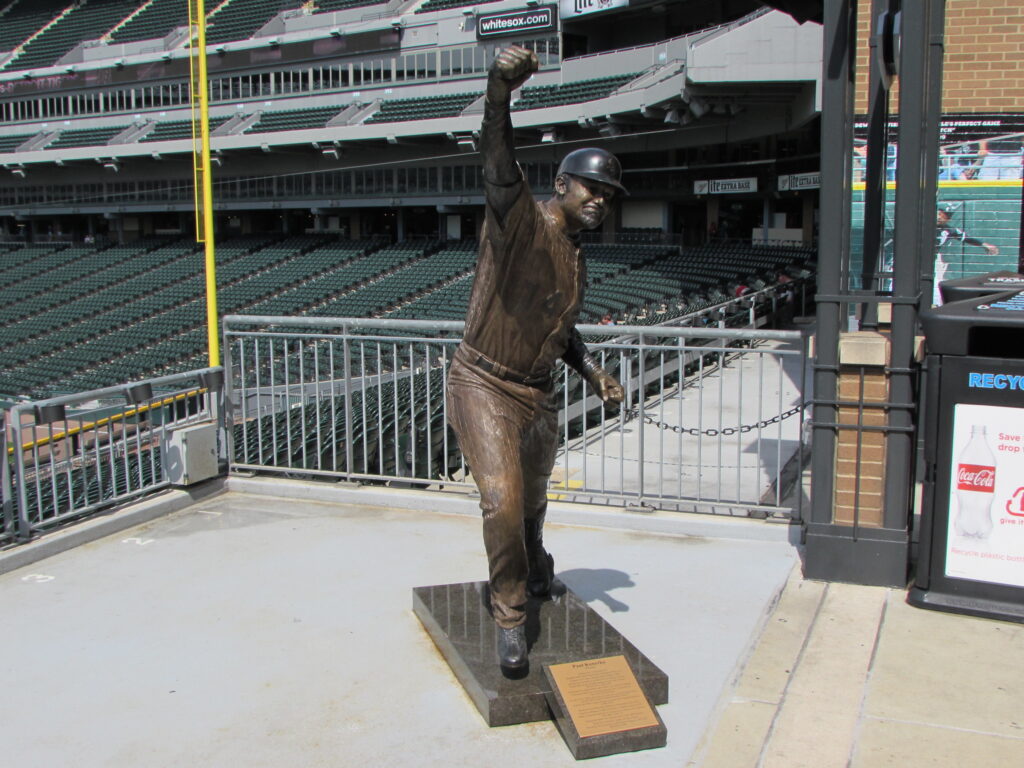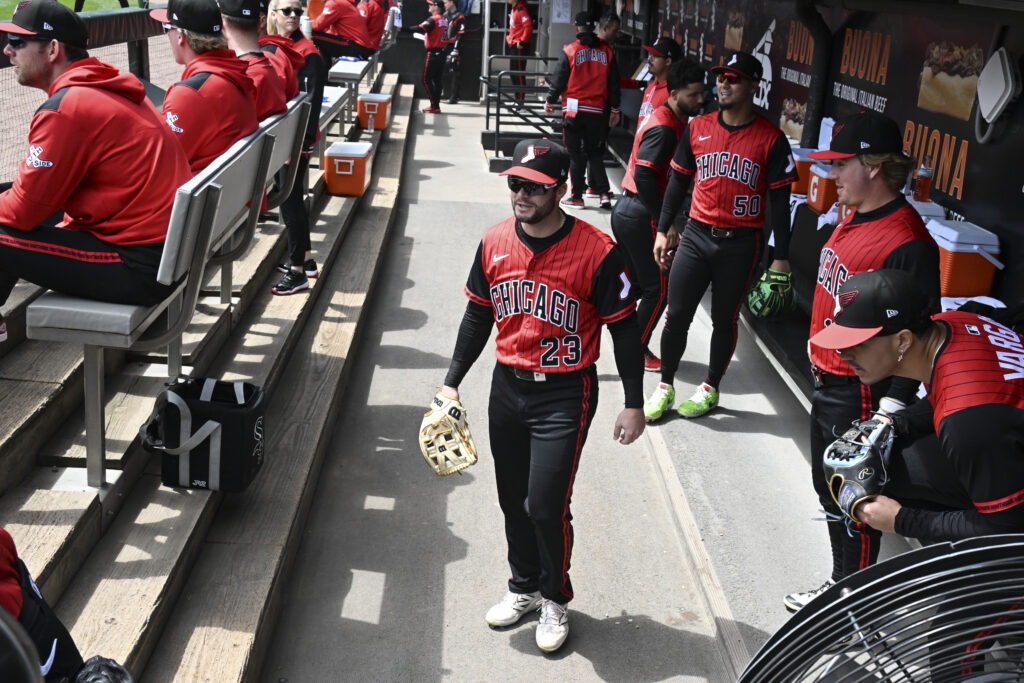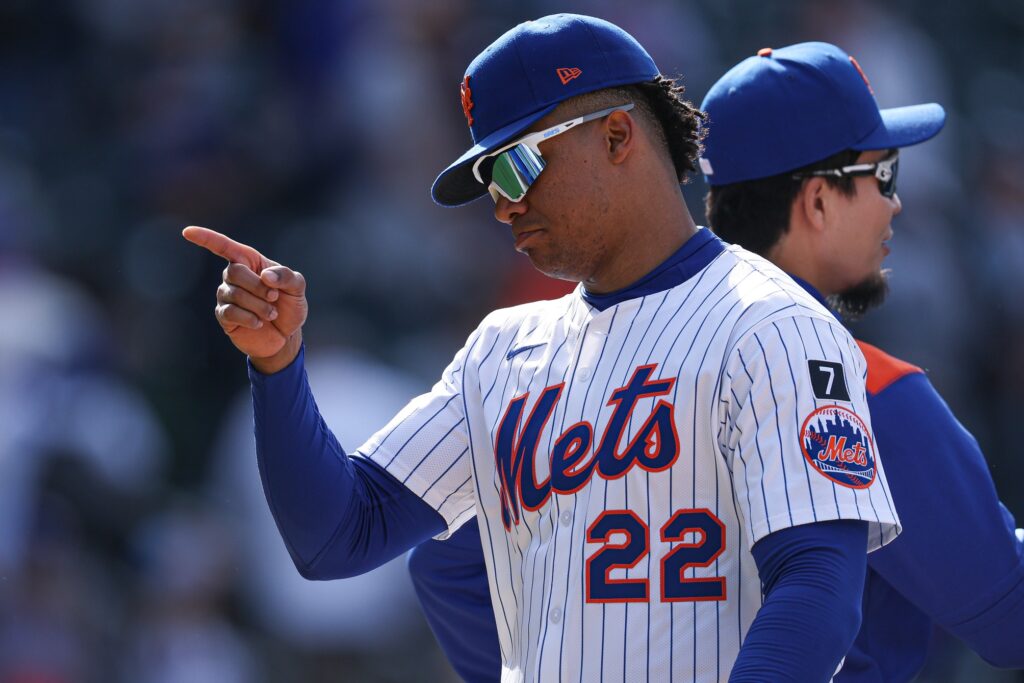This is the second article in a series that looks at the five best players at each position for the Chicago White Sox. In this installment are first and third basemen, as well as designated hitters.
Many teams up to this point (Braves, Red Sox, and Cubs) have seen the outfielders as the stars on offense, that will not be the case with the White Sox. Their best players come mostly from the infield, especially first base, where they have had three bona fide stars over the past 30 years.
The Best Corner Infielders and DHs in Chicago White Sox History
First Basemen
Honorable Mentions – Joe Kuhel was a starter during some of the club’s down years in the 1930s and ’40s. His best season was in 1940 when he set career highs with 111 runs and 27 home runs to go along with 169 hits, 94 runs batted in, and a .280 average. In eight seasons with the White Sox (1938-43 and 46-47), Kuhel totaled 523 runs, 874 hits, 75 home runs and 382 RBIs in 899 games.
Greg Walker was a starter for Chicago for nine seasons (1982-90). He had a sold year in 1985 and set career bests with 85 runs scored, 27 home runs, and 94 runs batted in two years later. Walker had 746 hits, 113 homers, and 444 RBIs in 841 games. He went 1-for-3 for the White Sox during the 1983 American League Championship Series.
5. Frank Isbell – He was the starter during the White Sox’s first decade (1901-09), which includes the team’s first championship. Nicknamed “Bald Eagle,” Isbell’s best season was the club’s first. He set career highs with 93 runs, 70 runs batted in, and a league-leading 52 stolen bases in 1901. In 1,074 he amassed 484 runs, 1,019 hits, 447 RBIs, and 250 steals (third-most in team history). Isbell had eight hits, four runs scored, four doubles, and four runs batted in during the team’s World Series victory over the Cubs in 1906.
4. Earl Sheely – He took over for Chick Gandil after the “Black Sox” Scandal and had six straight seasons with at least 150 hits and 80 runs batted in. Sheely’s best season was 1925 when he set career highs with 93 runs, 189 hits, 43 doubles, and 111 RBIs. “Whitey” played seven seasons with the White Sox (1921-27) and had 479 runs, 1,051 hits, 580 RBIs, and a .305 average in 948 games.
3. Jose Abreu – The Cuban-born slugger earned three All-Star selections and three silver slugger awards during his nine years in Chicago (2014-22). Abreu hit .317 with 80 runs, 176 hits, 36 home runs, and 107 RBIs in 2014 to win the Rookie of the Year award. He led the league with 123 RBIs in 2019 and won the MVP and Hank Aaron awards the following year after leading the league with 76 hits and 60 runs batted in to go along with 43 runs, 19 home runs, and a .317 average in the COVID-shortened 2020 season. “Oso” (Spanish for “Bear”) hit .292 in 1,270 games with the White Sox. He ranks third in franchise history with 234 home runs and also is fifth in RBIs (868), sixth in doubles (303), seventh in total bases (2,509), and tenth in both runs (697) and hits (1,445). Abreu had nine hits, a home run, and five RBIs in seven playoff games with the White Sox. He signed with the Astros for the 2023 season.
2. Frank Thomas – Although many fans remember him as a first baseman, he actually played more games as a designated hitter, so he gets the top spot at that position. The “Big Hurt” led the American League with 46 home runs in 1992 then won back-to-back MVP awards. In 1993, he totaled 106 runs, 174 hits, 36 doubles, 41 home runs, 128 runs batted in, and a .317 average. The following year, he hit .353, equaled his run total (which also led the league), and he added 34 doubles, 38 homers, and 1,010 RBIs. Thomas made the All-Star team five times in seven seasons at first base (1992-97), won the 1995 All-Star Home Run Derby, earned two silver slugger awards, and went 6-for-17 with a home run and three RBIs in the 1993 ALCS.
In his 16-year career (1990-2005), he hit over .300 and drove in at least 100 runs ten times each, scored over 100 runs and had at least 30 doubles nine times apiece and had 150 or more hits and smacked 30 or more home runs eight times each. Thomas is the all-time franchise leader in runs (1,327), doubles (447), home runs (448), and RBIs (1,465). The Hall of Famer also ranks second in total bases (3,949), fourth in both games played (1,949) and hits (2,136) and is tied for tenth in average (.307).
1. Paul Konerko – Thomas was able to shift to designated hitter because of Konerko’s production at first base. In 16 years with the White Sox (1999-2014), Konerko had 150 or more hits 11 times, had at least 30 doubles eight times, scored more than 80 runs and hit at least 30 home runs seven times apiece, drove in at least 100 runs six times and hit better than .300 in four seasons.
The six-time All-Star and 2014 Roberto Clemente Award winner was especially good in the playoffs, totaling 18 hits, seven home runs, and 17 RBIs in 19 postseason games. Konerko earned the ALCS MVP award in 2005 after going 6-for-21 with two home runs and seven runs batted in, and he followed that up with a homer and four RBIs in the World Series sweep of the Astros. He is the all-time franchise leader in total bases (4,010) and he ranks second in games played (2,268), home runs (432) and RBIs (1,383), third in hits (2,292) and doubles (406) and fourth in runs (1,141).
Third Basemen
Honorable Mentions – Lee Tannehill started as a shortstop and moved to the “hot corner” during his 10-year stint in Chicago (1903-12) which included the team’s first championship in 1906. The light-hitting Tannehill had 833 hits and 346 RBIs while hitting just .220 in 1,090 games. George “Buck” Weaver was a good fielder who saw his career come to a premature end due to his part in the “Black Sox” Scandal (he didn’t take bribes, but he knew about the others and said nothing).
Weaver spent his nine-year career (1912-20) split between shortstop and third base. His best season was his last, driving in 74 runs and setting career highs with a .331 average, 102 runs, 208 hits, and 34 doubles in 1920. Weaver hit .272 with 623 runs, 1,308 hits, 198 doubles, 420 runs batted in, and 173 stolen bases in 1,254 games. He had seven hits, three runs, and an RBI in the 1917 championship victory and 11 hits and four runs scored in the World Series two years later. Weaver became a pharmacist in Chicago after he received his lifetime ban from baseball.
Pete Ward also spent time in left field during his seven-year run in Chicago (1963-69). He finished second to teammate Gary Peters in the 1963 Rookie of the Year voting, then put together his best season the following year, hitting .282 and adding career-bests with 23 home runs and 94 runs batted in. Ward had 753 hits, 97 homers, and 407 RBIs in 899 games played.
Current White Sox star Yoan Moncada was known to the baseball community before he came up to the big leagues. He was the MVP of the MLB Futures Game in 2016 after hitting a two-run home run in the eighth inning. Moncada’s best season was 2019 when he set career highs with a .315 average, 83 runs, 161 hits, 34 doubles, 25 homers, and 79 runs batted in. In seven seasons (2017-present), he has 351 runs, 655 hits, 86 homers, and 317 RBIs in 690 games. Moncada also has five hits and three runs scored in seven postseason contests.
5. Joe Crede – He spent just five of his nine seasons (2000-08) as a starter but one of those was the team’s championship campaign. Crede won a silver slugger award in 2006 after batting .283 and setting career highs with 76 runs, 154 hits, 30 home runs, and 94 runs batted in. The 2008 All-Star totaled 712 hits, 125 homers, and 403 RBIs in 798 games. Crede hit .289 with 13 hits, three doubles, four home runs, and 11 RBIs during the 2005 playoffs.
4. Jimmy Dykes – He started as a second baseman and played all four infield positions during his 15 years with the Philadelphia Athletics (which included two titles), and he continued to be a versatile player in seven seasons with the White Sox (1933-39). Dykes was a two-time All-Star who appeared in the first game in 1933. He had his best season the following year when he hit .269 with 52 runs, 122 hits, seven home runs, and 82 runs batted in. Overall, Dykes batted .272 with 551 hits and 307 RBIs in 580 games.
3. Bill Melton – He was a solid power hitter during his eight-year stint in Chicago (1968-75). “Big Bill” had back-to-back seasons with 33 home runs, and he led the American League and earned his only All-Star selection during his second of those years in 1971. He hit at least 20 home runs five times and drove in 80 or more four times with the White Sox. Overall, Melton had 448 runs, 901 hits, 154 homers (ninth-most in team history), and 535 RBIs in 976 games.
2. Willie Kamm – He was a solid fielder who played with only two winning teams in his nine seasons (1923-31) with the post “Black Sox” team in Chicago. Kamm had five seasons with at least 30 doubles, and he drove in 80 or more runs four times. He totaled 545 runs, 1,136 hits, 243 doubles, 67 triples, 588 runs batted in, and a .279 average in 1,171 games.
1. Robin Ventura – He was known for his slick fielding and timely hitting during his ten seasons with the White Sox (1989-98). The 1992 All-Star and five-time gold glove winner had his best season in 1996 when he hit .287 with 105 runs batted in and career highs with 96 runs scored and 34 home runs. Ventura had six seasons with at least 80 RBIs and five with more than 80 runs scored and 20 home runs.
He ranks seventh in team history with 171 home runs and sits ninth with 741 RBIs, while also totaling 658 runs, 1,244 hits, 219 doubles, and a .274 average in 1,254 games. Ventura homered and drove in five runs in the 1993 ALCS, but his three greatest moments were winning the gold medal with Team USA in the 1988 Summer Olympics, his “fight” with Nolan Ryan during a game in 1993, and his game-winning “grand slam single” for the Mets against the Braves in Game 5 of the 1999 National League Championship Series.
Designated Hitters
5. Greg Luzinski – The four-time All-Star with the Phillies earned two Designated Hitter of the Year awards (now called the Edgar Martinez Award) with the White Sox. His best season was 1982 when he batted .292 with 170 hits, 18 home runs, and 102 runs batted in. Luzinski had 496 hits, 84 homers, and 317 RBIs in 992 games with Chicago. He went 2-for-15 with a double in the 1983 ALCS loss to the Orioles.
4. Adam Dunn – His career seemed to usher in the “all or nothing” era we have seen in the past few years. “Big Donkey” hit just .201 in four seasons with the White Sox (2011-14), but he showed plenty of power. In 2012, he was an All-Star despite hitting .204 due to his 41 home runs and 91 runs batted in, plus league-leading totals of 105 walks and 222 strikeouts (also a career-high). Dunn had 106 homers, 278 RBIs, and 720 strikeouts in 528 games with Chicago.
3. Jim Thome – He was coming off elbow and back injuries when he was traded from the Indians to the White Sox after the 2005 season. Thome responded in 2006 with 108 runs scored, 42 home runs, and 109 runs batted in to win the Comeback Player of the Year award and earn his only All-Star selection with Chicago. He played four seasons with the White Sox (2006-09) and totaled 335 runs, 469 hits, 134 home runs, and 369 RBIs in 529 games. Thomas was inducted into the Baseball Hall of Fame in 2018.
2. Harold Baines – He split his 14 seasons with Chicago (1980-89, 96-97, and 2000-01) evenly between right field and designated hitter. As a DH in the later part of his White Sox tenure, Baines was selected to a pair of All-Star games, was a two-time Designated Hitter of the Year winner, and was named a silver slugger in 1989.
Although his numbers tailed off at the end of his career, he totaled ten seasons with 20 or more doubles, eight with at least 80 runs batted in, and seven each with at least 150 hits and 20 home runs. Baines hit .288 and ranks fourth in franchise history in home runs (221) and RBIs (981), fifth in doubles (320), sixth in hits (1,773), tied for seventh in games played (1,670) and eighth in runs scored (786). He also had a double and a run scored during the 2000 Division Series. Baines was voted into the Baseball Hall of Fame by the Veteran’s Committee in 2019, a move that has led to many an argument over Hall of Fame induction standards.
1. Frank Thomas – While his full career was discussed in his first base profile, he spent nine of his 17 seasons as a designated hitter (1991 and 98-2005). In that time, Thomas won two silver slugger awards and had three seasons with at least 30 home runs and four with 100 or more runs batted in. Despite not being an All-Star at the position, he hit .285 and totaled 646 runs, 1,053 hits, 232 doubles, 223 homers, and 720 RBIs in 1,041 games. The “Big Hurt” saw his final two seasons marred by a foot injury, which led to his retirement. He was inducted into the Baseball Hall of Fame in 2014, his first year of eligibility.
Upcoming Stories
Chicago White Sox Catchers and Managers
Chicago White Sox Second Basemen and Shortstops – coming soon
Chicago White Sox Outfielders – coming soon
Chicago White Sox Pitchers – coming soon
Previous Series
A look back at the Chicago Cubs
Chicago Cubs Catchers and Managers
Chicago Cubs First and Third Basemen
Chicago Cubs Second Basemen and Shortstops
Chicago Cubs Outfielders
Chicago Cubs Pitchers
A look back at the Boston Red Sox
Boston Red Sox Catchers and Managers
Boston Red Sox First and Third Basemen
Boston Red Sox Second Basemen and Shortstops
Boston Red Sox Outfielders and Designated Hitters
Boston Red Sox Pitchers
A look back at the Baltimore Orioles
Baltimore Orioles Catchers and Managers
Baltimore Orioles First and Third Basemen
Baltimore Orioles Second Basemen and Shortstops
Baltimore Orioles Outfielders and Designated Hitters
Baltimore Orioles Pitchers
A look back at the Atlanta Braves
Catchers and Managers
First and Third Basemen
Second Basemen and Shortstops
Outfielders
Pitchers
A look back at the Arizona Diamondbacks
Catchers and Managers
First and Third Basemen
Second Basemen and Shortstops
Outfielders
Pitchers



